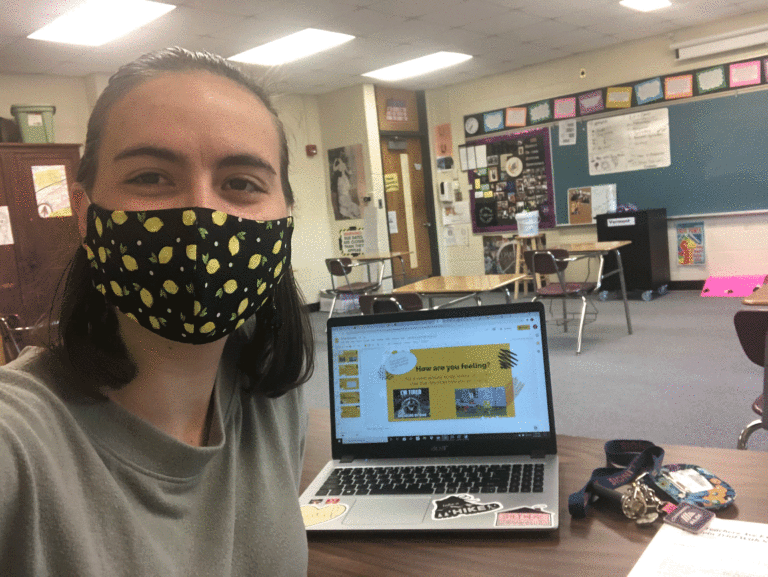URBANA – Since March 2020, when regular classroom teaching was curtailed due to the COVID-19 pandemic, teachers have been juggling transitions between remote, hybrid, and in-person learning; changing class schedules; students with a wide variety of technical needs; and their own mental and physical health.
Some Champaign-Urbana teachers say trying to help their students through these unprecedented times and keep teaching during the pandemic has been draining. And they say their administrators didn’t provide much to support their emotional or mental wellbeing.
Scott Filkins, an English teacher at Central High School in Champaign, says most of the emotional and mental support he got wasn’t from the administration, but from his colleagues.

“We were all constantly checking in on each other,” said Filkins. He says the teachers would have small, unofficial meetings and would send each other notes to help keep everyone going. But he says there wasn’t any real support for the teachers’ mental health from the administration, a feeling he found was shared by teachers in other school districts.
“I don’t know of any district that did support their teachers exceedingly well,” said Filkins, “because this hasn’t happened before. I didn’t hear any of my teacher friends from other cities and other states saying, ‘Man, they gave us all the answers.’ And nobody was asking for that, but I do feel we didn’t get checked in on enough. I do feel strongly about that. And I think part of that comes from, if you check in on somebody and they ask for something and you don’t know how to provide it, it just feels awkward. So I think at a certain point, it was just like ‘Well, they seem to be doing okay,’ so there wasn’t the same effort to check in on us as there was to check in on students.”
Filkins adds that he and other teachers knew that this was a difficult time for administrators as well, and that “large systems aren’t very good at dealing with this kind of thing.”
Ellen Reckamp student-taught at Urbana High School in the spring semester of 2021 and will be teaching Special Education English there starting this fall. She says the situation was similar at her school.
“The admin didn’t really do anything specifically with our mental health, social-emotional well-being, anything like that,” said Reckamp. “I feel like the teachers tried to lean on each other, and I think that’s a concern going into the fall too. Transitioning back to in-person is going to be hard for a lot of different reasons, and we’re hoping that the admin will have better supports.”
What the research shows
Dr. Lia Sandilos, an assistant professor of psychology in education at Temple University, studies the quality of classroom environments and their effects on teacher efficacy. She says that stress and lack of support for teachers isn’t just a problem for the health and wellbeing of educators—it’s also affecting the quality of their work.
Sandilos says she’s found that inter-staff and staff-student relationships, as well as support for teachers’ emotional wellbeing, are very important for teachers to be effective at their jobs.
“Working conditions are really important,” said Sandilos. “Relationships in the school are important, and so is asking teachers how they’re doing. If teachers aren’t waking up and feeling good about the school day or they don’t feel like they can meet the demands of their jobs, it’s not only going to impact their physical and mental health, but it also affects how they function in the classroom. Often, teachers with reduced well-being don’t have as high quality interactions with kids. They don’t have the emotional resources to really engage with students to create a warm, positive environment in the classroom.”

And the pandemic has only created more stressors for educators and students, who will often share those problems with their teachers. Besides the complications of remote learning like a lack of Chromebooks and students without Wi-Fi, one of the things Reckamp says was really hard about the school year was hearing from all of her students about all of the difficult things going on in their lives and not being able to do much for the kids because everything was over Zoom.
“The hardest thing was these students would tell you all of the things that they’re struggling with in their lives, and it’s hard to help the students when you’re over Zoom and you don’t see them in person,” said Reckamp. “As a teacher, it’s really draining if you have all of these students unloading on you. You have all these kids who are really struggling, and they don’t have a place to let it out because they’re stuck at home.”
Possible Solutions
Sandilos says that of the teachers she’s talked to for her research, the majority said that they understood their administrators were doing their best with the situation that the pandemic had created. But they said that as teachers, they didn’t really feel their needs and concerns were heard and taken into account by the administrators. A smaller group of the teachers said that they felt heard by their administrations when it came to policy decisions, and those teachers reported much better working conditions.
Many teachers, including Filkins, say their school districts didn’t give them much in the way of the support or resources they needed to make the switch to a new style of teaching, which was another source of stress.
Sandilos says that as simple as it sounds, just giving teachers a seat at the table where decisions are being made created a much more positive, and less stressful, work environment that was better for teachers and their students, even during the pandemic.
Another suggestion for improving work environments and therefore teachers’ well-being that Sandilos has is based on the behaviors of teachers themselves. She says that remote learning and the pandemic forced teachers to be creative and work together, and teachers who reported working with colleagues usually reported better outcomes.
“One thing that really came up was that they worked together,” Sandilos said. “I heard from teachers that if they were in a pod together or a bubble or all in the same hallway that they collaborated and shared ideas with each other, and that was something that was really positive for them. I think another thing leaders can do is to really encourage and facilitate opportunities for teachers to collaborate even more.”
Sandilos acknowledged that her research is focused largely on the immediate classroom and school environments and where teachers can draw support from those areas. But she did say that other research has shown that a practice of mindfulness can be helpful for teachers who are particularly struggling with stress.
Otherwise, she advises teachers to lean on their various relationships within the school. She suggested finding support from colleagues and getting help when approaching school leadership if teachers don’t feel comfortable going on their own, as well as using relationships with students in the classroom to find satisfaction and positivity.
“When teachers are able to, at least within their own classrooms, cultivate a really positive, warm climate, it not only helps the students, but I think it also really helps the teachers’ emotional states,” said Sandilos.

